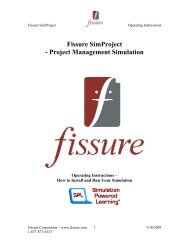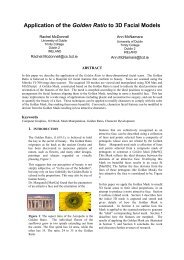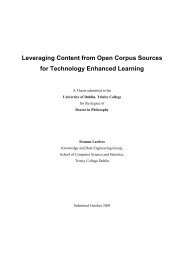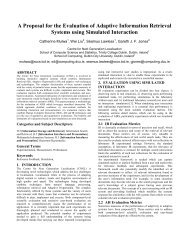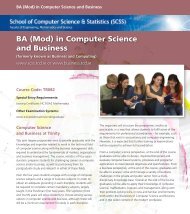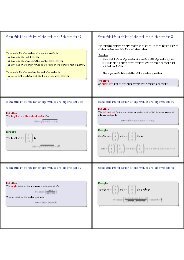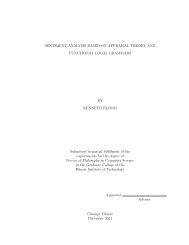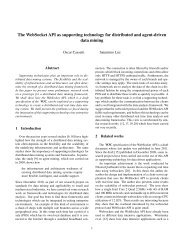Situations from events to proofs 1 Introduction
Situations from events to proofs 1 Introduction
Situations from events to proofs 1 Introduction
Create successful ePaper yourself
Turn your PDF publications into a flip-book with our unique Google optimized e-Paper software.
and<br />
L |− C L ′ iff (∀x ∈ C)(∀y ∈ ext(L, x)) ext(L ′ , x) ≠ ∅<br />
iff (∀x ∈ C)(∀y ∈ ext(L, x)) e(L ′ , x) ∈ L ′ .<br />
Adopting the familiar sequent format Γ ↦−→ Θ for an assertion (or judgment)<br />
Θ based on assumptions (or context) Γ, we might then express L ☎ L ′ as<br />
and L |− C L ′ as<br />
x ∈ L ↦−→ e L ′(x) ∈ L ′ (13)<br />
x ∈ C, y ∈ ext(L, x) ↦−→ e(L ′ , x) ∈ L ′ . (14)<br />
If we are <strong>to</strong> replace e L ′(x) and e(L ′ , x) by terms t(x) and t ′ (x, y) that can be<br />
formed through a system of rules, we must beef L ′ up <strong>to</strong> E L ′(x) and ext(L ′ , x)<br />
respectively, 6 resulting in<br />
for (13) and<br />
x ∈ L ↦−→ t(x) ∈ E L ′(x) (15)<br />
x ∈ C, y ∈ ext(L, x) ↦−→ t ′ (x, y) ∈ ext(L ′ , x) (16)<br />
for (14). In both (15) and (16), the first variable typed, x, relativizes the<br />
languages of all other terms appearing in the sequent (L ′ in (15), and L, L ′ in<br />
(16)). To isolate the variable x <strong>to</strong> the left of ↦−→, we can put (16) as<br />
x ∈ C ↦−→ (λy ∈ ext(L, x)) t ′ (x, y) ∈ ext(L, x) → ext(L ′ , x)<br />
with a function (λy ∈ ext(L, x)) t ′ (x, y) <strong>to</strong> the right of ↦−→. The example of<br />
e(L ′ , x) <strong>from</strong> (14) for t ′ (x, y) suggests the function need not consult y during its<br />
computation; the typing y ∈ ext(L, x) serves simply <strong>to</strong> ensure that the search<br />
for a string in ext(L ′ , x) succeeds, provided L |− C L ′ . At any rate, we need not<br />
worry about termination of the computation, so long as we bound the search<br />
<strong>to</strong> strings occurring in (or, in the case of t(x), subsumed by) x.<br />
With these functions in mind, let us call a function f on strings over the<br />
alphabet Pow(Φ) a ☎-map if for all s ∈ Pow(Φ) ∗ , s ☎ f(s). If we collect in<br />
L ☎ → L ′ all ☎-maps that send strings in L <strong>to</strong> strings in L ′<br />
f ∈ L ☎ → L ′<br />
def<br />
⇐⇒ f is a ☎-map and (∀s ∈ L) f(s) ∈ L ′<br />
then we can reduce L ☎ L ′ <strong>to</strong> the non-emptiness of L → ☎ L ′<br />
L ☎ L ′ iff L → ☎ L ′ is inhabited (i.e. non-empty) .<br />
6 This is because we can no longer rely on the fact that for all languages L and strings x,<br />
e L(x) ☎ x and e(L, x)◮x.<br />
17



